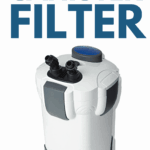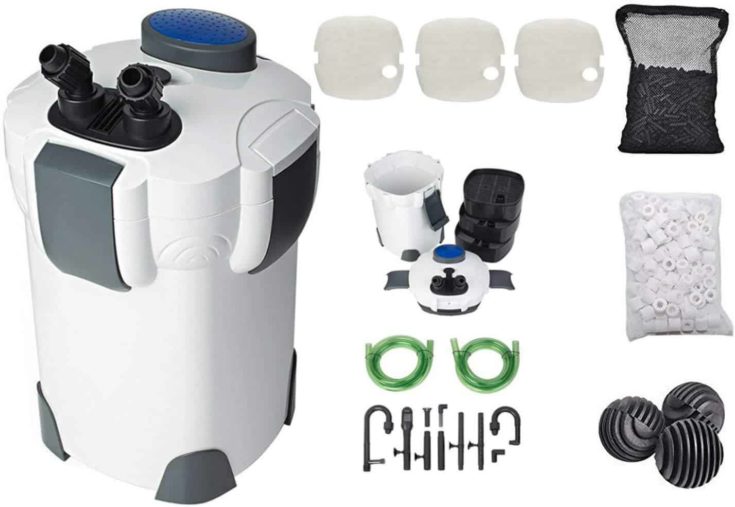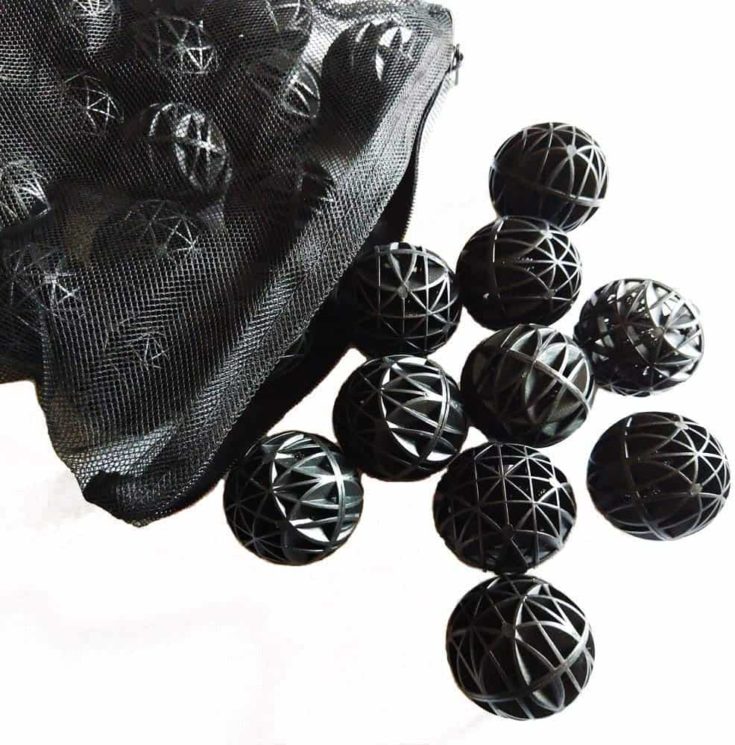How To Set Up A Canister Filter

Canister filters are dandy, aren't they? Powerful, pressurized water filtration that gets your water crystal articulate and nearly-limitless possibilities for customizing the filter media that you utilize can't be beaten, correct? I'm inclined to concord, only there are another thing canister filter owners can by and large agree on likewise: the instructions that come up packaged with filters tin at times be terrible, and setup is often the hardest function, especially for beginners.
How are y'all supposed to get your filter working correctly without instructions? Are you up to date on aquarium prep? How to set canister filter media? Where to position your filter? Do you lot know how to cut your hoses, or attach them to your canister and run them to your tank? Information technology'due south an involved process, and information technology'due south piece of cake to miss a step. Thankfully, the internet (and yours truly) are here to show you how to set upwards a canister filter.
What You Need To Get Started

It should go without maxim, but y'all'll need your filter, it'south components, and all your media to become started. The exact components that come up with your item filter may vary, but in full general, you'll have the following:
- Hoses
- A Motor
- Tank Connectors
- Hose Clamps
- Hose Clips
- Intake Assembly
- Output Assembly
- Filter Canister
- Media Trays or Baskets
- Media Bags
- Foam Inserts
- Ceramic Rings
- Activated Carbon
Generic Hosing
The standard hosing tin sometimes exist stiff and hard to handle. You want your tubing thick, but it should withal be pliable and free of any kinks. Instead of ordering branded replacement tubing for the filter, I similar to go with a roll of generic vinyl hose tubing that can be cut to the length y'all need. It's less expensive, usually less hassle than working with the tubing that comes with your filter, and you'll have plenty of extra on mitt just in case of an emergency.
Bio-Balls

Depending on your filter, it may come pre-packaged with ceramic rings as its chief biological filtration media. Some folks prefer bio-balls, nevertheless, every bit they degrade much slower.
Phosphate Removers
Activated carbon is a pop media for chemical filtration, merely I prefer adding a bit of phosphate remover as well to help control algae growth in my aquarium.
Actress Foam
Your filter might have come with ane type of foam padding for mechanical filtration, but to optimize your results, you demand to have a combination of fibroid foam, fine foam, and extra-fine foam.
Instructions
i. Place Your Parts
Unpack everything, go your filter's part list, check that everything that should be there, is at that place. Your filter should come with everything that you need to start pumping. If your filter came bundled with media, yous'd want to check those to ensure they are non damaged, and suitable for use in your filter.
2. Prep Your Tank
Find a skilful spot for your filter to residue. Call back that your filter should be beneath your aquarium for optimal use. The ideal positioning of most filters falls between 8 inches and iv ½ feet below your tank'southward h2o level. Cheque your filter's guide to find yours. Yous'll also want to brand sure that your aquarium is filled to its maximum level, and that your hosing tin follow a direct path to your tank. Yous don't desire any loops, slack, or kinks in your tubing, so test your tubing before setup to make certain it can reach the tank with no bug.
3. Prep Your Filter
Now we start the procedure of getting our media prepare for the filter. Remove your filter'southward motor caput, and make sure that all of your media baskets are inside. Depending on your filter you may have iii or 4 baskets to fill. Assemble your preferred media, sort them out by type, and get ready to install them layer by layer. If you take any gap in the bottom of your filter when the baskets are inserted, consider lining the bottom with some quondam ceramic rings to lengthened whatsoever waste that will collect downward there.
4. Install Mechanical Media
Your mechanical media should be placed in the showtime tray of your filter. Why? After your filter draws water from the tank, information technology then flows from the start tray of the filter and and so is forced to the other layers, becoming cleaner with each pace. Mechanical filtration should be the first step in this process, so that when water gets to the biological and chemical stages, the filter media at that place won't get clogged with waste and debris. Take your 3 foam varieties: coarse, fine, and actress fine, and stack them in the tray from bottom to pinnacle in that gild. Each layer will filter out smaller and smaller particles, preparing it for the next stage in the process.
5. Install Biological Media
You should add your preferred biological media to the second tray from the lesser. As mentioned, some tank owners like the ceramic rings, others adopt the bio-assurance. Others still favor using something known equally Biohome for all of their filtration needs, and skip out on mixing media birthday. Yous may elect to store your biological media in filter numberless but at that place are plenty of tank owners who just line their trays with the biological media, to no sick effect.
6. Install Chemical Media
Your third and 4th trays (if you have a 4th tray) are complimentary for you to mix things up. You're free to use them for more of the same media if that'south what yous feel most comfortable with. You could as well experiment, and try calculation some chemical media to the mix. Activated carbon is a pop choice, as are phosphate removers like PhosBan. These media oft come as loose granules, and so if you do choose to add together them, using a filter bag is very of import (outside of the bag, the granules can start to migrate, and potentially clog your filter's impeller).
seven. Prepare Intake
Now nosotros can get our intake, the part of the filter that draws water from the tank, prepared. Some filters accept a connector that attaches to the tank holding the hoses in place. Fasten the connector to the tank. So attach your hose to the filter past loosening the intake clamp, attaching the hose to the intake valve, then tightening the clamp up again.
Run your hosing to the tank, cutting your hose to length (no slack, no loops), so secure your hosing to the connector. The end of the hose should spike to an intake tube that lowers into the tank water. If your manual doesn't have a recommendation on how far the tube should extend into the water, fall dorsum on the iii-inch rule, which advises to keep the cease of the tube at least iii inches from the lesser of your tank.
8. Gear up Output
This volition be done in much the same way every bit our intake training. Prepare the tank connector, attach your hose to the filter, measure & cut, then send your hose to the tank. In this case, however, our output nozzle should rest at least an inch under the water line, it doesn't accept to lead all the way to the bottom of the tank.
9. Start Your Filter
This tin can vary from filter to filter. In general, however, you volition desire to check that everything is connected securely, and in the proper place. Brand sure that your valves are open up and so that the filter can draw so expel water from your tank. Some filters will crave that you have h2o in the canister to begin, so ensure the necessary amount is in the chamber earlier starting. When you are satisfied that everything is ready, plug in your filter.
If it has an motorcar-prime feature, the filter will run for a bit to get the h2o flowing, then turn off to force excess amounts of air from the canister, information technology will then run continuously until y'all turn it off. If you lot have a priming push for your filter, y'all may need to pump that a few times to get it going.
10. Sentry Your Tank Become Cleaner
Find your filter in activity for a while, and make certain everything's running smoothly. Some filters might brand some rattling noises during showtime up. If these noises persist, however, you lot might desire to bank check to make sure no debris is clogging any of the filter components. Watch your flow rate. If it seems to exist lower than expected, you may have to tighten your hose connections, or remove obstructions from your tubing.
Determination
Wasn't that fun? Hopefully y'all're at present a bit more clued in on how to set up your canister filter, and some basic operational procedures. Every bit I mentioned, the instructions that come with a lot of filters aren't always the clearest or easiest to follow, then it'southward helpful to have a step-past-stride guide that can break out some of the difficult-to-decipher language into easier terms.
What do you think? Were these steps helpful in breaking down the filter setup process? Whatsoever extra steps or tips yous think should be included? Permit me know your thoughts in the comments, and remember to share the article if you plant it useful!
Source: https://www.tankarium.com/how-to-setup-canister-filter/

0 Response to "How To Set Up A Canister Filter"
Post a Comment